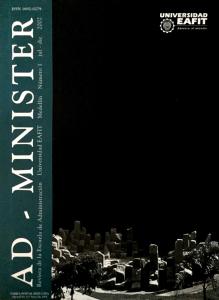Portfolio Capital Flows: Not an unmitigated blessing. A literature survey
Main Article Content
Keywords
Abstract
This paper is a literature survey on capital flows to developing countries. It analyzes thecharacteristics of the different components of capital flows. It also focuses on the factors,internal and external, that make capital flow into developing countries, as well as on theconsequences of these flows -and their reversals- on the health of the recipient economies.Finally, it surveys the policies that have been implemented to handle them in search for themost recommendable ones. Its main conclusion is that capital inflows play a very importantrole for developing countries by being an alternative for these economies to undergo a pathof growth, a possibility that otherwise will be undermined by the lack of sufficient domesticsavings. However, there is a large number of risks associated with capital inflows which aremagnified by the fact that capital-importing countries usually do not have neither adequateinstitutions, deep financial markets, strong banking systems, nor enough macroeconomicexpertise. All these factors put together make capital inflows to developing countries “notan unmitigated blessing”
Downloads
Download data is not yet available.
References
Bernard, L. and J. Cardoso. Managing capital flows: Lessons from the experience of Chile. IMF WP/ 98/168.
Calvo, G., L. Leiderman, and C. Reinhardt. “The Capital inflows problem: concepts and issues”. Contemporary Economic Policy. Vol.12. July, 1994.
Cardenas, M. and F. Barrera. “On the effectiveness of capital controls: The experience of Colombia during the 1990s”. Journal of Development Economics, Vol.54 (1997) 27-57.
Chen, Z. and M.S. Khan. Patterns of capital flows to emerging markets: A theoretical perspective. IMF WP/97/13.
Chuhan, P., S. Claessens, and N. Mamingi. “Equity and bond flows to Latin America and Asia: the role of global and country factors”. Journal of Development Economics (Netherlands); 55:439- 63. April, 1998.
Claessens, S., M. Dooley, and A. Warner. “Portfolio capital flows: Hot or Cold?”. . The World Bank Economic Review (International): 9: 153-74. January 1995.
Edwards, S. 1999. How Effective Are Capital Controls? NBER Working Paper No. 7413.
Fernandez-Arias, E. and P.Montiel. “The surge in capital inflows to developing countries: an analytical overview”. The World Bank Economic Review 10(1), (1996), 51-80.
Johnston, B. and N.Tamirisa. Why do countries use capital controls?. IMF WP/98/181. Kim. S, S.
Kim and Y.Wang. Capital Account Liberalization and Macroeconomic Performance: The Case of Korea. Forthcoming.
Kim, Y. “Causes of capital flows in developing countries”. Journal of International Money and Finance, 19 (2000) 235-253.
Lopez-Mejia, A. Large capital flows: A survey of the causes, consequences, and policy responses. IMF WP/99/17.
Singh, A. and B.Weisse. Emerging stock markets, portfolio capital flows and long-term economic growth: micro and macro perspectives. World Development. Vol.26 No.4 (1998) pp.607-622
Calvo, G., L. Leiderman, and C. Reinhardt. “The Capital inflows problem: concepts and issues”. Contemporary Economic Policy. Vol.12. July, 1994.
Cardenas, M. and F. Barrera. “On the effectiveness of capital controls: The experience of Colombia during the 1990s”. Journal of Development Economics, Vol.54 (1997) 27-57.
Chen, Z. and M.S. Khan. Patterns of capital flows to emerging markets: A theoretical perspective. IMF WP/97/13.
Chuhan, P., S. Claessens, and N. Mamingi. “Equity and bond flows to Latin America and Asia: the role of global and country factors”. Journal of Development Economics (Netherlands); 55:439- 63. April, 1998.
Claessens, S., M. Dooley, and A. Warner. “Portfolio capital flows: Hot or Cold?”. . The World Bank Economic Review (International): 9: 153-74. January 1995.
Edwards, S. 1999. How Effective Are Capital Controls? NBER Working Paper No. 7413.
Fernandez-Arias, E. and P.Montiel. “The surge in capital inflows to developing countries: an analytical overview”. The World Bank Economic Review 10(1), (1996), 51-80.
Johnston, B. and N.Tamirisa. Why do countries use capital controls?. IMF WP/98/181. Kim. S, S.
Kim and Y.Wang. Capital Account Liberalization and Macroeconomic Performance: The Case of Korea. Forthcoming.
Kim, Y. “Causes of capital flows in developing countries”. Journal of International Money and Finance, 19 (2000) 235-253.
Lopez-Mejia, A. Large capital flows: A survey of the causes, consequences, and policy responses. IMF WP/99/17.
Singh, A. and B.Weisse. Emerging stock markets, portfolio capital flows and long-term economic growth: micro and macro perspectives. World Development. Vol.26 No.4 (1998) pp.607-622

